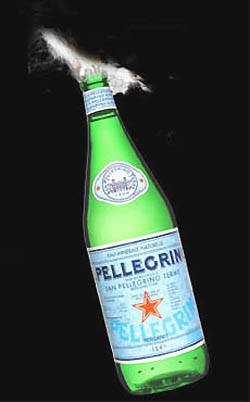TRENDS: Bottled Water News & Blues
 To drink, or not to drink: That is the question. |
Americans consume 97.5 liters of bottled water per capita (25.76 gallons), according to Nestlé, the world’s largest water bottler. In 2006, 8.25 billion gallons’ worth of bottled water was sold, a 9.5% increase over 2005. More bottled water is sold than milk, and it almost has caught up to beer. According to the economic consulting firm ECONorthwest, bottled water sales are expected to exceed carbonated soft drinks in overall sales volume in the next decade. Nestlé, which sells 72 brands of bottled water in 37 countries, had a 38.5% market share of the North American market in 2006. The company’s brands include imports Aqua Panna, Contrex, Perrier, San Pellegrino and Vittel; U.S. brands Arrowhead, Deer Park, Ice Mountain, Ozarka, Poland Spring and Zephyr Hills; and brands under the Nestlé label, such as Aquarel. The introduction of flavored water and enhanced water (water with added vitamins, herbs and extracts) has aided growth of bottled water. Both represent a small, yet rapidly-growing, segment of the market—197% for flavored water and 41.7% for enhanced water in 2005, the most recent year for which statistics are available. These products are typically made from filtered, municipal tap water or well water rather than from spring water; Twist, which we reviewed recently, uses artesian well water (it’s also kosher and organic). | |
| All is not rosy, in watervile, however. ECONorthwest does stress that the bottled water industry is coming under increased scrutiny for a number of its practices. Something so seemingly healthy is the antithesis of “green.” The bottling process is very inefficient: Nestlé, for example, reports that it requires 1.86 liters of water to produce one liter of bottled water. The landfill of plastic bottles—more than 75% of bottles are never recycled—has environmentalists up in arms. The fuel usage and emissions that arise from trucking so many billions of gallons of water around the country (and shipping water around the world) has a negative environmental impact. There are also questions regarding the purity of bottled water, which is not inspected by the government, compared to tap water, which is rigidly checked by municipalities. Finally, communities that have aquifers (underground sources of water) find large water companies moving into their towns to pump and sell their water. In towns like Fryeburg, Maine, Poland Spring pumps 200 million gallons a year from the local aquifer (water that locals say should be flowing naturally into the local pond), bottles it, and, in the words of community organizers, “wears out our roads trucking it out of town.” While Poland Spring has offered free cases of bottled water to the first 50 people who come to their office in Fryeburg for “hot coffee and real communication,” a local advocate, Howard Dearborn, is offering $10 to the first 50 people who pour their Poland Spring water “back into Lovewell’s Pond, where it belongs.” It’s a 21st-century Boston Tea party. Read more at DefendingWaterInMaine.org and WaterWaves.org.These environmental concerns have begun to affect consumer behavior and could slow or reverse the growth in what has been a spectacular market. Examples, previously reported in Gourmet News & Views, include directives from city governments, led by San Francisco, to cease purchase of bottled water with city funds; and the cessation of sale of bottled water by some restaurants. However, fine bottled water that is enjoyed for its unique properties—like Perrier, San Pellegrino and Vittel makes up a small amount, perhaps 15%, of water sales in the U.S. The bulk of sales goes into gallons, five-gallon containers, and the millions of filtered tap water products like Aquafina and Dasani, for which there are alternativs—filters on water taps, and Better Water Drinking Water Filter Bottle, a refillable, biodegradable plastic bottle made from corn resident with a built-in filter that makes tap water taste great, is good for 90 uses. Each biodegradable bottle saves 90 plastic bottles from landfill. We highly recommend it as a holiday gift, for everyone you know who totes around water bottles. | ||